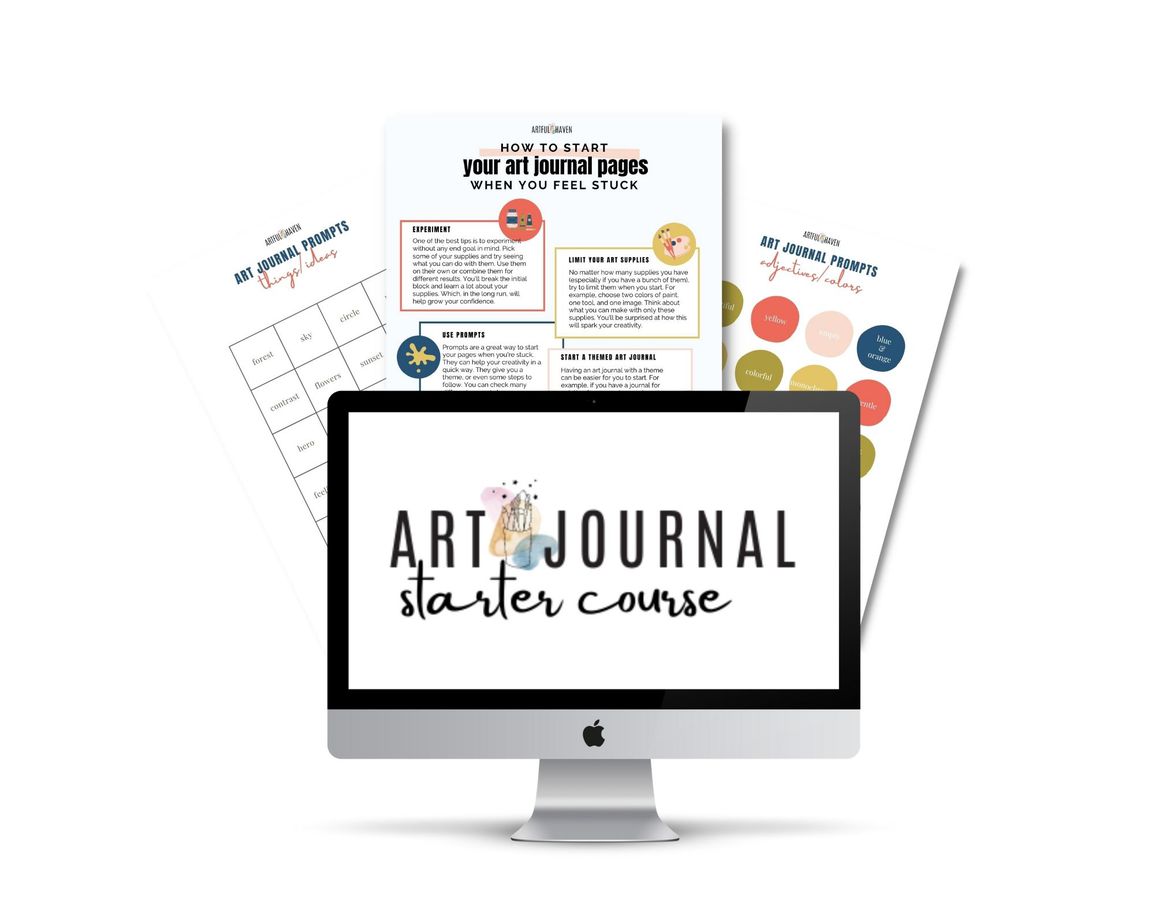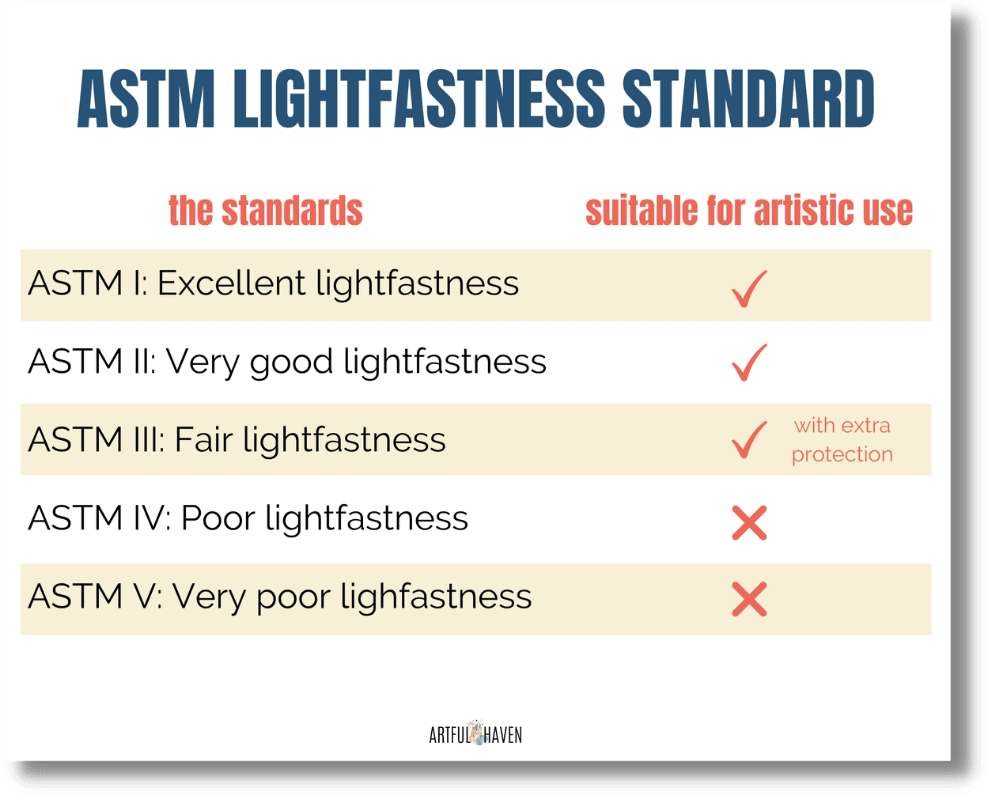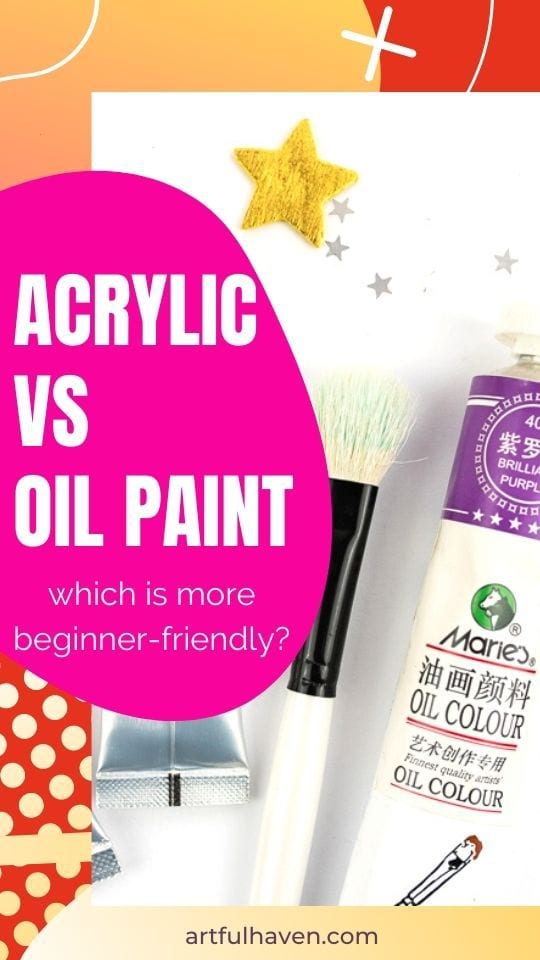Acrylic vs Oil Paint Differences (Which Is More Beginner Friendly?)
You like to paint, you’re curious about different paints and media, then you must have wondered about the differences between acrylic vs oil paints.
That’s why I wanted to share a bit about both of them, compare them, and finally focus on the best choices for beginners.
Neither of them is better. They’re both great paints and have their own pros and cons, depending on where you’re at in your artistic journey.
So here are the main acrylic vs oil paint differences.
Disclaimer: Some links in this post may be affiliate links. This means that if you purchase something through that link, I get a small commission, at no extra cost to you.
What is oil paint?
Oil paints are just what their name reveals: oil-based paints. This means that their pigments are held together by oil. They’re also characterized by slow-drying time, great blending possibilities, and depth of color.
What is oil paint used for?
The reason many artists like oil paints is that they’re so easy to blend. Their slow-drying time and creaminess let artists blend them without the fear of them drying too fast. So, it gives them a lot of time to get the effects they want.
People often use oil paint on canvases to produce landscape paintings with a lot of depth or portraits with a soft-blended look.
Also, these paints can be used for thicker techniques applied with palette knives.
What is acrylic paint?
Acrylic paint is a water-based paint that’s fast-drying and hence gives you little time for blending. You can use water with it (or not), you won’t have to wait for too long for it to dry, and once it’s dry, you have no worries about smudging it with liquid media again.
What is acrylic paint used for
You can use it for painting on many different surfaces:
- Paper
- Plastic
- Canvas
- Textile
- As an adhesive
In art journaling, it’s mainly used on paper and the great thing is that you can use it even on thinner papers. You don’t have to use mixed media paper for acrylic paints. It’s a great medium for art journaling, especially for beginners.
Acrylic vs oil paint differences
Here are some main differences between acrylic and oil paints that might help you decide which you can use in your art projects. I’ll emphasize the important info for beginners, especially in art journaling.
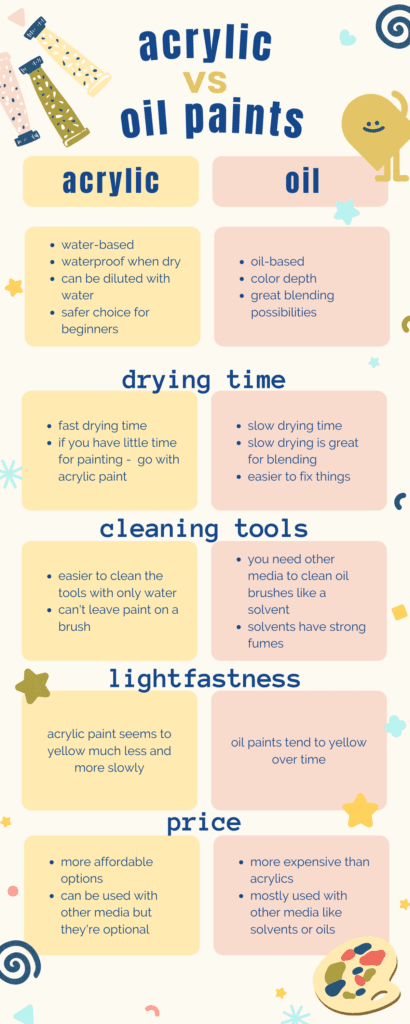
Drying time
The one thing you should remember is that oil paints take much longer to dry than acrylic paints. This is important to know for your “work speed” needs.
If you have little time for painting – then you should go with acrylic paint. They’ll dry fast and you can add multiple layers on top quickly, and have enough time to experiment and finish your piece. But just bear in mind that this quick drying time leaves you fewer possibilities for blending.
If you have more time for painting and like working slowly – try out oil paints. Their slow-drying time will allow you to blend for a longer time, and to even fix things. However, you’ll need to wait for the paint to dry for more than 24 hours.
So, if you work in an art journal, you’ll need to leave it open until it dries. Also, oil paints are visible on the back of the paper.
I tried them in my mixed media art journal, with thick paper, and the paint is clearly visible on the back of the paper.
Blending and mixing with oil paint vs acrylics
Mixing oil paints is easier than acrylics. What’s even more, oil paints dry more slowly so you have a great amount of time to mix them the way you want.
On the other hand, acrylics tend to dry faster so mixing is also limited.
When it comes to blending, it’s pretty much the same. Since oil paints have oil in them, they run smoothly over your surface and allow you to blend colors more easily.
Again, it’s the slow-drying time that helps you fix things, add things, and blend over and over again until you’re satisfied.
Acrylic paint is blendable, but you need to do it more quickly. You can add water to make it even more blendable and to make it moist, but if you add too much, you can dilute them into watercolors.
Cleaning your tools
Cleaning your tools after both, acrylics and oil paints, is important. If you leave a brush with acrylic paint on it, you can forget about it later (fast drying time + acrylic plastic-like finish result in useless brushes).
When you paint with acrylics, clean your brushes right after you finish painting. Wash them with warm water gently, squeeze the rest of the water out of them, shape the brush with your fingers, and leave it horizontally to dry.
After painting with oil paints, it’s a different story. You can leave your brush in oil (I use baby oil)after finishing for the day, and tomorrow, your brush will still be ready for painting.
If you want to clean it thoroughly, dip it in a solvent (or oil) and then slowly clean it on a paper towel. Do this a number of times, until the trace on the paper is clean. Shape the brush with your fingers and that’s it.
It does take longer to clean oil paint brushes, so include this in your painting time.
Also, solvents can be really smelly because of their fumes, and harmful.
So, there are a few alternative products to help you clean the brushes.
Acrylic vs oil paint lightfastness
Lightfastness in paint is its capability to resist light affecting it. If the paint has great lightfastness, it means that it won’t change in value or color with time or being exposed to light.
There are levels of lightfastness is marked by Roman numbers. If they have mark I, they have great light resistance. The higher the number, the less lightfast the paint is.
I’ve read a lot about the lightfastness of oils and acrylics. I couldn’t believe these things can get complicated. However, since we’re mostly focusing on art journaling, here is the main conclusion on the topic:
Oil paints tend to yellow over time which is due to the oil they’re made with. It’s been a problem since the beginnings of oil painting and yet, there’s still no better solution than to just accept this fact.
On the other hand, acrylic paint seems to yellow much less and more slowly. So, most artists believe the yellowing of the acrylic paint isn’t that much of an issue, as it can be with oil paints.
The lightfastness of paint is usually marked on the packaging, although I’ve learned that student-grade paints usually don’t have these marks at all.
The change in color when they’re dry
After an oil painting is dry, the colors in it may look faded. This is due to many factors (including chemistry) which I believe is too much to digest at this moment.
Also, oil paintings will turn yellow over time, due to the oil inside them. This won’t happen with acrylic paint.
However, when acrylic paint dries, it slightly changes its color. The colors can look darker or lighter when they’re dry.
I’ve been using student-grade, matte acrylic paints, and they mostly dry lighter. However, some acrylic paint, like glossy ones, will dry darker.
These changes in color are not a big problem, since they’re subtle. Even more, if you’re into art journaling, these things won’t matter to you.
Layering
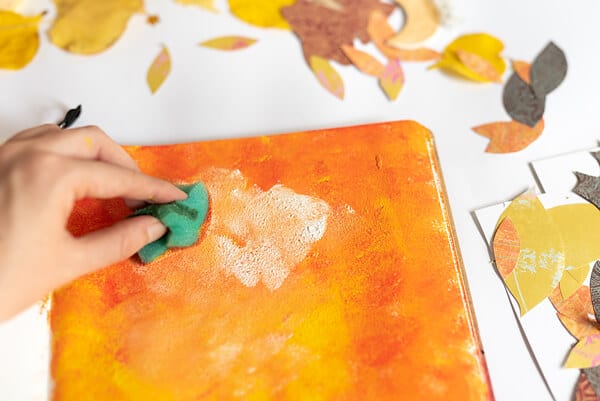
Since acrylic paint dries more slowly, thick layers are easier to do. You can experiment with more layers, or even paint in the Impasto technique.
Oil paints, on the other hand, take longer to dry, and layering them can be a hassle. Especially when you know that some oil colors tend to dry faster than others. Oh, sometimes it just looks like a lot of work.
Thick layers are possible with oil paints, but you’ll get there slowly, and maybe even end frustrated (if just experimenting & enjoying is your jam, and you’re not selling or exhibiting your art).
What’s your space like, small or big?
One thing about oil paints everyone seems to warn about is their strong smells. However, this smell mostly comes from the solvents used with oil paints, mostly for cleaning.
So, if you have a very small space to work in, maybe think about this factor.
Either way, always keep a window open when you paint with oils and use solvents.
Acrylic paints, on the contrary, don’t have strong smells because they’re water-based. They’re even safe for children to play with. If you’re still worried, read the labels on your paints.
Moreover, if your acrylic paint really stinks, it’s probably gone bad and you should get rid of it.
The surface for painting
As with any kind of paint, the surface you’re working on is important and affects the end result.
Since oil paints have oil in them, it’s pretty obvious that some of that oil will be soaked by thin and porous surfaces like thin paper. It seems the best thing with oil paints is to use a primer to separate the paints from the surface.
I’ve tried using oil paints in my art journal without gesso as a primer, the paper is mixed media paper (so, thick paper) and I can see that my image is clearly visible on the other side of the paper.
And I didn’t use any solvent. I just painted right out of the tubes, for experimentation.
On the other hand, acrylic paints don’t require a primer in this sense. Although you can use gesso if you have very thin paper. But acrylics will work on many surfaces, many kinds, and thicknesses of paper.
That’s why art journalists love acrylic paint, it’s really a go-to paint for experimenting and playing.
Which one is easier to use?
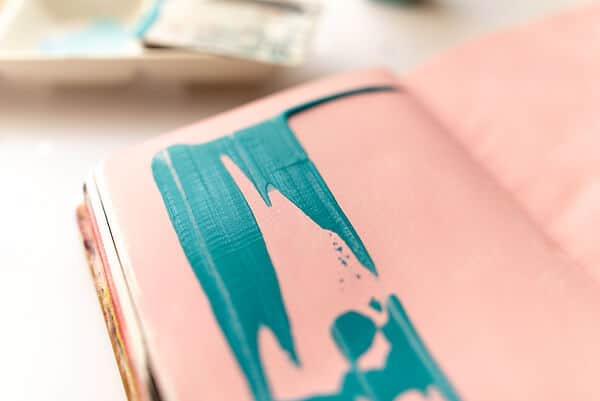
In my experience (although I haven’t painted much with oil paints), acrylic paints are easier to use.
To use oil paints and achieve their best results, you’ll need some extra things:
- Solvents – for thinning the paint and speed up the drying time
- Medium (oil) – for adding it to the paint and making it more fluid
- Separate brushes
- A primer
- Ventilated space
- More time
When it comes to acrylic paint, all you need is the paint, some paper, and a brush.
Also, it’s easier to clean brushes from acrylic paint than oil paint. You just wash them with water.
In the end, it all depends on your desired results and preferences. Oil paint is an excellent choice for painting, it’s been around for centuries and produces lovely and soft results.
With acrylic paint, you can also achieve amazing results, in less time and with fewer tools/media.
Cost of acrylic vs oil paint
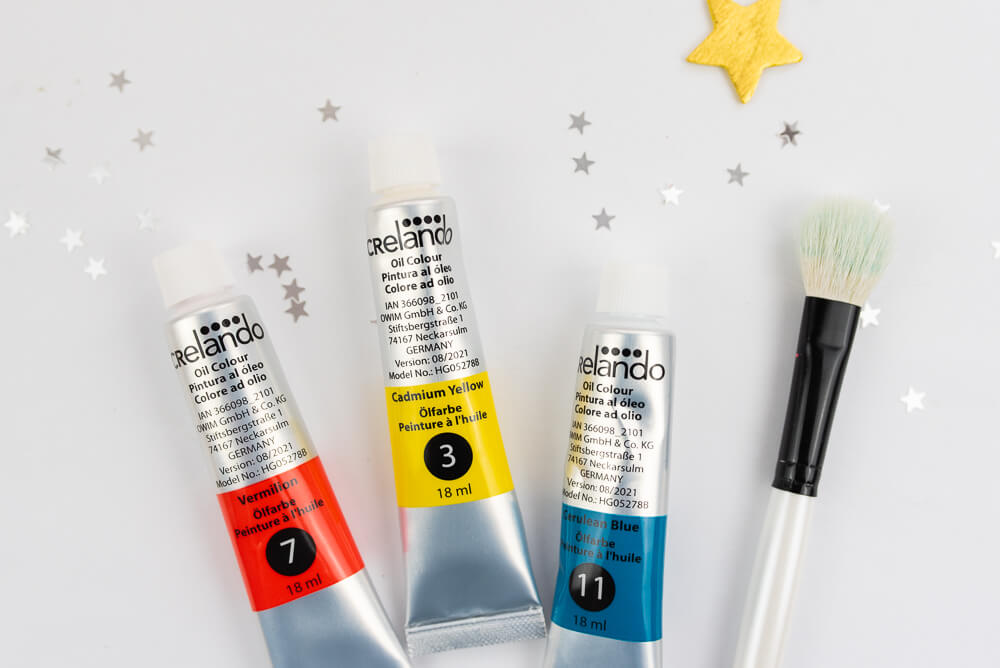
The price of paints is always on the mind of an artist. With paints, this is the rule of thumb: the higher the price, the more professional paint you’ll get.
When you compare the prices of acrylic vs oil paints, oil paints are more expensive. Not only are the tubes pricey, but you also need to get a solvent, and maybe a special brush, a canvas, a primer, etc.
You can get student-grade oil paints and play with them if you’re curious. I believe I got my pack of 24 tubes for around 12 Euros.
On the other hand, getting acrylic paint on a budget is much easier. They’re almost everywhere. For playing and experimenting, you can find student-grade acrylic paint in many different kinds of shops.
Best oil paint brands
I’ve mostly used student-grade oil paint. You know, the ones that children can also use for school. I chose them because I just wanted to experiment a bit and see how these paints behave.
So, I’m going to list some of the beginner-friendly oil paints that are also affordable.
M. Graham Artists’ Oil Paints and Sets
Best acrylic paint brands
When it comes to acrylic paint, there are so many brands to choose from. Here are a few I found to be affordable and a good start for beginners.
Blick Studio Acrylic Paints and Sets
Acrylic vs oil paint – Which is better for beginners?
Acrylic paint is definitely more suitable for beginners than oil paint. This is because it’s just easier to work with it, it dries faster (if you’re impatient, this is a great thing), it’s more affordable, and you don’t need any extra media to paint with it.
With acrylics, it’s also easier to experiment and you can do so on any kind of paper, so it’s excellent for art journaling.
Oil painting can be too much of a task for a beginner. You’d need primers, solvents, or alternatives, separate brushes, learn new techniques, deal with slow drying time and fumes, etc.
However, if you’re curious enough to start painting with oils, get yourself some affordable ones, splash a bit of gesso on your paper, and experiment. Just don’t start with expensive ones right away.
Then the fear of wasting paint might haunt you. And you should feel free while painting, right?
All in all, if you’re a complete beginner, I think you should choose acrylic paints to start with, and then later build your skills with oils as well.

